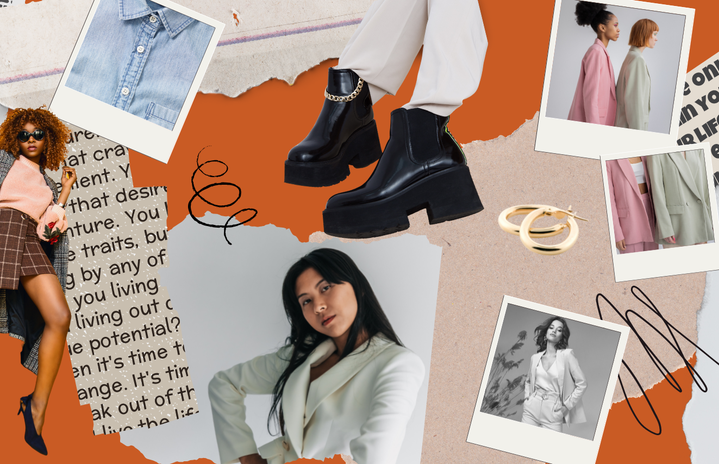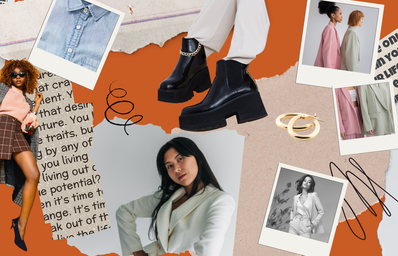Our attitudes towards our clothes are deeply influenced by popular culture and the seemingly endless stream of fashion microtrends popularised online. This vicious cycle encourages us to view clothes as disposable, specifically due to the rapid and drastic shifts between the different styles of clothes seen as ‘in’, causing our new purchases to become quickly less appealing and prematurely obsolete. When these newfound concerns are combined with the persistent pressure of ever-changing female beauty standards, it is no wonder that so many of us struggle to feel positive and empowered in the clothes we wear.
I would like to emphasise that this article does not aim to attack or condemn those who buy clothes from fast fashion businesses. It goes without saying that whilst this industry is exploitative and environmentally harmful, few people can afford the privilege of shopping sustainably, and it is not my place to make judgements about how each person navigates feeling good in their clothes given these economic inequalities. Considering the complexity of the comprehensive issue, this conversation will be predominantly focused on the emotional impact of our individual relationship with clothes, rather than our collective attitude towards them as consumers.
By no means have I arrived at a place where I feel completely confident in my clothes all of the time; especially because I have found this to be an unrealistic goal to strive towards today. However, the following tips have noticeably improved my relationship with my external appearance and the way I dress, whilst allowing me to limit unnecessary expenditure and work mainly with the clothes I already own. I can only hope they might do the same for someone else who is currently struggling with the frustration and self-doubt that results from the dreaded ‘nothing looks right’ clothing dilemma.
Thinking creatively with your clothes
Due to the various social and online pressures mentioned above, it is not uncommon to feel a certain obligation to replace the majority of our wardrobes each season, or even be reluctant to wear the same outfit twice. Unfortunately, adhering to the expectations of microtrends can become both emotionally and financially draining. But fear not; there are more effective and enjoyable solutions readily available, such as refreshing your wardrobe with the help of affordable DIY methods. For example: knitting or crocheting clothes – an activity that has garnered much attention since the first lockdown. Whilst this is a more complex and prolonged project, the resulting sense of achievement and gratitude in being able to wear the finished product is overriding. Furthermore, there are significant therapeutic benefits of carefully crafting each item from scratch, rendering this a refreshing holistic approach to feeling good in your clothes from start to finish of their creation.
A less time-consuming option is to rework your old clothes by sewing, cropping, dyeing or painting them. You might even raid your parents’ cupboards for their unwanted preloved items that you can put to better use, experimenting with different fits or layering different clothes to add dimension to your outfits. Or if you’re looking for a less permanent option, organising a temporary clothes swap with a friend is a great way to become inspired by new styles or colours that you would usually avoid, providing an opportunity to build your confidence by stepping out of your comfort zone.
Embracing change is often the best solution if you feel stuck in a rut, and although it initially seems daunting, I have found that implementing small yet brave new fashion choices can do the world of good for your self-esteem. The choice to dress intuitively provides the freedom to express and honour our personal preferences, whilst adding a unique flare to the way in which we present ourselves. Not to mention, creative activity itself is mood-boosting; therefore functioning as a simultaneously emotionally and materially rewarding process which ensures long-lasting fulfilment.
Material expectations versus reality
Whilst these practical tips are both useful and accessible in terms of gaining more creative licence over our clothes, they only go so far in terms of healing the relationship between ourselves and our external appearance. Ultimately, the liberating realisation that you are not obliged to change anything about your appearance in order to prove your worth is the first step towards loving yourself in whatever you wear – whether it be a personalised outfit, or clothes preserved in their original, unaltered form.
For me, healing has also involved learning to value my body for its strength and versatile functions, rather than for the ability to appear desirable in certain clothes. However simple they may seem, activities such as stretching, walking, yoga and dancing have made a significant difference in allowing me to appreciate my body for the way it supports me, as this is something we can often forget amidst the expectation that we must dress to please others. Because this expectation is still prominent today, teaching myself to accept the periodical moments of insecurity it generates without internalising this negative self-talk has been the most important learning curve. This can be achieved by practising regular affirmations (either by writing in a journal or verbally reciting them) in order to remind yourself of how much you have to offer beyond the often superficial narratives surrounding fashion, bodies and valuability.
Feeling good in the clothes we wear is indeed a work in progress; and in fact, the means of dressing confidently and comfortably are vastly different for each of us. With this in mind, it is key to remember that regardless of whether you make no material changes to your appearance, or whether you crave change and transformation, your individual worth and uniqueness is permanent and unchanging!


